Paul Bishop's Blog
May 26, 2022
BRIT SPY—THE RAT CATCHERS
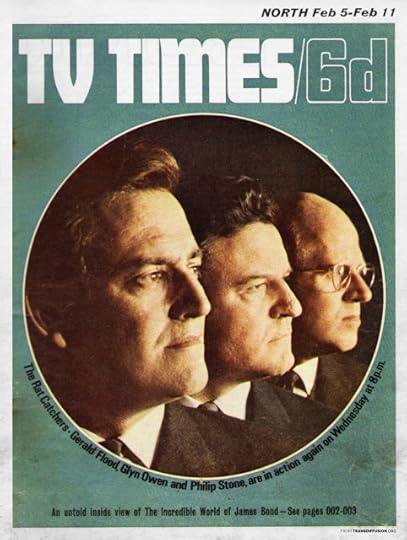 BRIT SPY—THE RAT CATCHERS
BRIT SPY—THE RAT CATCHERS With the ‘60s spy craze at its height with James Bond controlling the big screen and The Man From U.N.C.L.E. ruling the small one, British TV channel ITV decided it needed to get in on the espionage fad with a series of it’s own. The result was The Rat Catchers, running for two seasons for a total of twenty-five, sixty minute, black and white, episodes between February 1966 and March 1967. Some of the stories arcs continued over two or three episodes utilizing cliff-hanger endings, but all are suffused with class issues and the dirty truths of the espionage game.
A precursor to two iconic and much better remembered British spy series—Callan, which premiered in 1967, and The Sandbaggers, which would come a decade later—The Rat Catchers focused on the missions carried out by a small, highly secret, British Intelligence Unit created to deal with the most dangerous of enemy menaces. The unit, nicknamed the Rat Catchers, is staffed by three determined and capable operatives—the flamboyant Peregrine Smith; the cold and logical Brigadier Davidson; and tough Scotland Yard detective Richard Hurst, all of whom are licensed to kill when expedient.
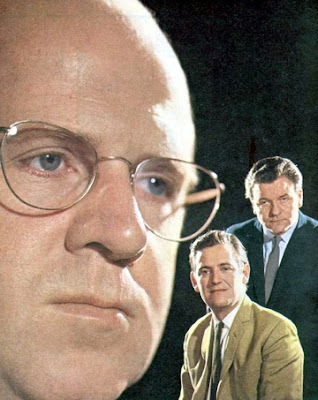 As with many of TV’s secret spy teams, the Rat Catchers don’t officially exist, being denied at the highest levels of government. Clearly expected to operate with the greatest of discretion, the Rat Catchers receive their orders direct from the Prime Minister. They are expected to follow these orders without question as they battle enemy spies, saboteurs, and others who threaten the security of Great Britain and the Western Alliance.
As with many of TV’s secret spy teams, the Rat Catchers don’t officially exist, being denied at the highest levels of government. Clearly expected to operate with the greatest of discretion, the Rat Catchers receive their orders direct from the Prime Minister. They are expected to follow these orders without question as they battle enemy spies, saboteurs, and others who threaten the security of Great Britain and the Western Alliance.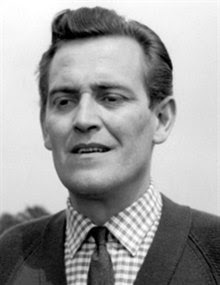 Peregrine Pascale Smith (Gerald Flood) is an Oxford University-educated managing director of the large Trans-World Electronics corporation. Brigadier General Davidson (Philip Stone) is the emotionless analytical brains behind the group. And Richard Hurst (Glyn Owen), is a Scotland Yard superintendent known for his by the book approach. Hurst inclusion in the unit is interesting in that, for all its secrecy, the unit still has enough pull among officialdom to request and get Scotland Yard’s top detective assigned to the team.
Peregrine Pascale Smith (Gerald Flood) is an Oxford University-educated managing director of the large Trans-World Electronics corporation. Brigadier General Davidson (Philip Stone) is the emotionless analytical brains behind the group. And Richard Hurst (Glyn Owen), is a Scotland Yard superintendent known for his by the book approach. Hurst inclusion in the unit is interesting in that, for all its secrecy, the unit still has enough pull among officialdom to request and get Scotland Yard’s top detective assigned to the team.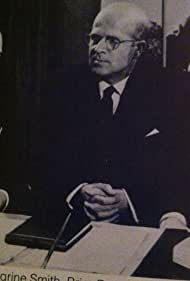 Brigadier General Davidson is a smallish man who very seldom smiles, though the edges of his mouth sometimes gives away a very subdued sense of humor. If he has a life outside his rather spartan offices on the fringes of Whitehall, he makes sure few know about it. A dour man, balding and bespectacled, he doesn’t appear to be someone who could order men to kill or die until you look into his eyes. Being a retired military man, his strict disciplinarian nature is always on display. Davidson has a sharp tongue and his biting retorts ensure the target of his ire will not be sitting down for a while.
Brigadier General Davidson is a smallish man who very seldom smiles, though the edges of his mouth sometimes gives away a very subdued sense of humor. If he has a life outside his rather spartan offices on the fringes of Whitehall, he makes sure few know about it. A dour man, balding and bespectacled, he doesn’t appear to be someone who could order men to kill or die until you look into his eyes. Being a retired military man, his strict disciplinarian nature is always on display. Davidson has a sharp tongue and his biting retorts ensure the target of his ire will not be sitting down for a while.Davidson does, however, demand independent thinking from his people, and for all his posturing, he will tolerate a modicum of insubordination as long as the agent is producing results—which is why he tolerates the antics of his oldest and most capable agent, Peregrine Smith.
From upper-class background, Smith is an Oxford schooled man who greatly enjoys the finer things in life and has the luck to be able to afford them. He goes for fast cars and pretty objects and appears to have few real worries. Smith likes everyone to think of him as a shallow raconteur, but when the situation calls for it, he can be incredibly cold-blooded.
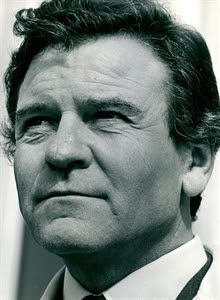 The newest Rat Catcher, Richard Hurst appears to be an out of place anomaly in the unit. He is a tough copper with a contempt for crooks and cons. His life work has been to put villains in jail, but his reverence for the law and procedure trumps everything else. He is not a man to go off reservation. If a culprit is discovered trading secrets or causing sabotage, Hurst believes he should be arrested and tried, all according to rules of law. However, this is not how the Rat Catchers operate, leaving Hurst struggling with his ethics and morals. Practically forced into the Rat Catchers because they needed his investigative skills, he could demand to be returned to the Yard, but he refuses to back away from a job to which he has been assigned—no matter how repugnant it is to him.
The newest Rat Catcher, Richard Hurst appears to be an out of place anomaly in the unit. He is a tough copper with a contempt for crooks and cons. His life work has been to put villains in jail, but his reverence for the law and procedure trumps everything else. He is not a man to go off reservation. If a culprit is discovered trading secrets or causing sabotage, Hurst believes he should be arrested and tried, all according to rules of law. However, this is not how the Rat Catchers operate, leaving Hurst struggling with his ethics and morals. Practically forced into the Rat Catchers because they needed his investigative skills, he could demand to be returned to the Yard, but he refuses to back away from a job to which he has been assigned—no matter how repugnant it is to him.The official cover for the activities of the Rat Catchers is the successful Trans-World Electronics. As its managing director, Smith has entry into many otherwise closed spots in officialdom due to TWE’s numerous government contracts. Hurst is on record as being the TWE Security Officer. The Brigadier, however, has no official capacity with the company, but he doesn’t appear to need it as he never leaves his office. Other Rat Catchers who have been killed in the performance of their duties are occasionally referenced.
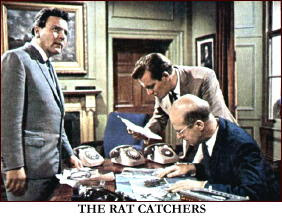 In the first episode, Hurst, joins the team as their new recruit. He is, however, unsettled in this new assignment. Due to the secrecy surrounding the unit, how they operate, and their specific mandate, the ruler-straight Hurst is unable to fully grasp the shadowy world he has entered. Maintaining the unit’s distance from Whitehall, Hurst feels isolated and adrift in his position, a situation complicated by Brigadier Davidson—the actual team leader—insisting Hurst should only know the bare minimum about the organization until he has proven himself.
In the first episode, Hurst, joins the team as their new recruit. He is, however, unsettled in this new assignment. Due to the secrecy surrounding the unit, how they operate, and their specific mandate, the ruler-straight Hurst is unable to fully grasp the shadowy world he has entered. Maintaining the unit’s distance from Whitehall, Hurst feels isolated and adrift in his position, a situation complicated by Brigadier Davidson—the actual team leader—insisting Hurst should only know the bare minimum about the organization until he has proven himself.The Brigadier repeats the catch phrase, Say so, if you understand me, each time he finishes a mission briefing to ensure Smith and Hurst carry out his orders to the letter. Performed by pianist Johnny Pearson, the full-length recording of The Rat Catchers Themeopens with the line, Say Yes, if you understand me, somewhat mimicking Davidson's catch-phrase, before launching onto a full piano and strings-led theme.
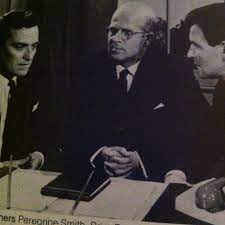 The Rat Catchers was far-removed from the glitzy and sexy world of James Bond and his ilk. Instead, the show operated in a bleak, uncompromising, and sordid underground world of fetid alleys, betrayal, and the baser instincts of humanity.
The Rat Catchers was far-removed from the glitzy and sexy world of James Bond and his ilk. Instead, the show operated in a bleak, uncompromising, and sordid underground world of fetid alleys, betrayal, and the baser instincts of humanity. That said, The Rat Catchers cleverly offset its sleazy portrayal of the subject matter with a veneer of travel and adventure—jet airplanes, international hotels, foreign locations. Episodes of the show take Smith, Hurst, and the Brigadier to Greece, Ireland, Madrid, Lisbon, and Stockholm, as well as domestic locations in and around London and the UK. At that time, only the very wealthy got to enjoy such exotic locations, and for regular viewers, the show was as much travelogue as espionage thriller.
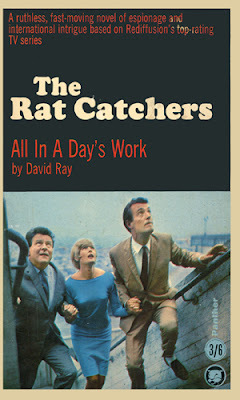 Nevertheless, despite this international flavor, production costs on the series were minimized wherever possible—common for British television at that time. This resulted in simple interior sets and outdoor footage largely consisting of cars sweeping down the street or people walking.
Nevertheless, despite this international flavor, production costs on the series were minimized wherever possible—common for British television at that time. This resulted in simple interior sets and outdoor footage largely consisting of cars sweeping down the street or people walking.The production company Associated-Rediffusion were the franchise holders in London and the south east of England for ITV from 1955-1968. When the franchise was taken over by Thames Television in 1968 almost all the Rediffusion archives—which included The Rat Catchers—were black and white recordings. When the UK started broadcasting in color in September 1969, the majority of black and white telerecordings were deemed of no further value and destroyed.
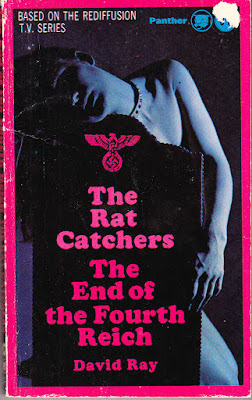 As a result, the only episodes of The Rat Catchersthat appear to have survived the purge are the first and third episodes of series one—Ticket to Madrid and The Unwitting Courier—and some action sequences from episode twenty three (series two), The Heel of Achilles. But the quality of these episode is very poor, apparently surviving only because they originate from a VHS copy of a 16mm film print obtained at a film convention. The rest of the series is missing presumed wiped.
As a result, the only episodes of The Rat Catchersthat appear to have survived the purge are the first and third episodes of series one—Ticket to Madrid and The Unwitting Courier—and some action sequences from episode twenty three (series two), The Heel of Achilles. But the quality of these episode is very poor, apparently surviving only because they originate from a VHS copy of a 16mm film print obtained at a film convention. The rest of the series is missing presumed wiped.Two Rat Catcher tie-in novels written by David Ray—All in a Day's Work and The End of the Fourth Reich were released during the shows original run on ITV. Both are original tales and well executed by the author, who manages to catch the flavor of the series within the books' fast moving action.
 Much thanks to Randall Masteller for letting me plunder and crib from the files of his Spy Guys and Gals website. To visit his site
CLICK HERE
Much thanks to Randall Masteller for letting me plunder and crib from the files of his Spy Guys and Gals website. To visit his site
CLICK HERE
A seven minute YouTube clip from The Unwitting Couriercan be found HERE
A recording of The Rat Catchers Theme on YouTube can be found HERE
Published on May 26, 2022 18:38
February 1, 2022
TIME TRAVEL CORNER—TIME WARS—SIMON HAWKE
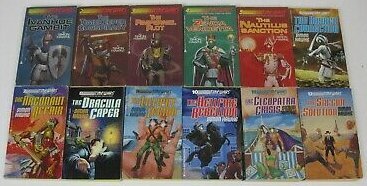 TIME TRAVEL CORNERTIME WARS—SIMON HAWKEIn the 27th Century, international disputes are resolved through time travel—clocking soldiers from the future into conflicts of the past. It seemed like an elegant way to solve the international disputes of the 27th Century—all the economic advantages of warfare without any of the devastation taking place in your own time. Multinational corporations and governments geared up for the effort, secure in the knowledge that since the past already happened, it could not be changed...or so went the theory. What could possibly go wrong?
TIME TRAVEL CORNERTIME WARS—SIMON HAWKEIn the 27th Century, international disputes are resolved through time travel—clocking soldiers from the future into conflicts of the past. It seemed like an elegant way to solve the international disputes of the 27th Century—all the economic advantages of warfare without any of the devastation taking place in your own time. Multinational corporations and governments geared up for the effort, secure in the knowledge that since the past already happened, it could not be changed...or so went the theory. What could possibly go wrong?However, it was quickly discovered that history could, indeed, be changed as a result of interference from the future—possibly catastrophically. Unfortunately, this quickly made discovery was not discovered quick enough to stop the ongoing Time Wars. To intervene and adjust the damage caused by historical disruptions, a special unit was created to preserve the continuity of the timestream.
However, as if going back into the past on missions to preserve the future wasn’t challenging enough, the elite First Division of the U.S. Army Temporal Corps face a new and much more dangerous threat, the Timekeepers—militarized radicals who believed the only way to stop the war machine is to create massive historical disruptions.
The battle for time has begun...
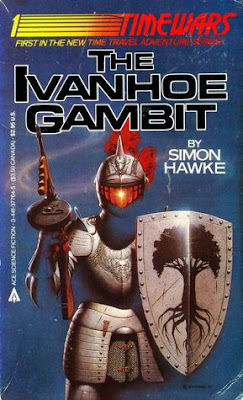 TIME WARS #1THE IVANHOE GAMBIT(1984)Sometimes Sergeant Major Lucas Priest wondered why he had enlisted in the U.S. Army Temporal Corps. Fighting in the Time Wars wasn't the easiest way to make a living. Sailing with Lord Nelson, battling Custer at Little Big Horn, and a year of pillaging with Attila and his Huns had left him ready for a vacation. But a demented scheme by the Timekeepers to impersonate the King of England is threatening to change the course of history.
TIME WARS #1THE IVANHOE GAMBIT(1984)Sometimes Sergeant Major Lucas Priest wondered why he had enlisted in the U.S. Army Temporal Corps. Fighting in the Time Wars wasn't the easiest way to make a living. Sailing with Lord Nelson, battling Custer at Little Big Horn, and a year of pillaging with Attila and his Huns had left him ready for a vacation. But a demented scheme by the Timekeepers to impersonate the King of England is threatening to change the course of history. Two army teams have already failed to intercept the madman, so Lucas and his men must clock back to the twentieth century to try and prevent an irreversible split in time. However, when Lucas discovers whom they are to impersonate, he gonna wish Hannibal had killed him back in Carthage...How were Ivanhoe, Robin Hood, and a band of merry outlaws supposed to protect the future of the world?
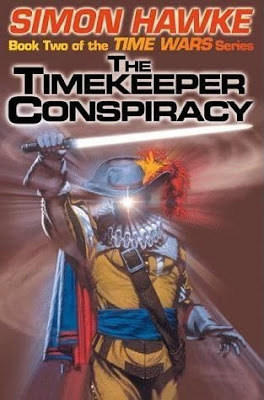 TIME WARS #2THE TIMEKEEPER CONSPIRACY(1984)At first the discovery of minus time seemed like a blessing. Countries at war could fight their battles in the past rather than destroy the present. But that turn out not to be the way it works. Now the situation has become desperate. Humanity faces the danger of a temporal split, with incalculable consequences, as a result of attempts to change the past.
TIME WARS #2THE TIMEKEEPER CONSPIRACY(1984)At first the discovery of minus time seemed like a blessing. Countries at war could fight their battles in the past rather than destroy the present. But that turn out not to be the way it works. Now the situation has become desperate. Humanity faces the danger of a temporal split, with incalculable consequences, as a result of attempts to change the past.When a covert agent of Temporal Intelligence gives his life to warn of a terrorist plot by the Timekeepers, Captain Lucas Priest and Private First Class Finn Delaney are clocked back to 17th Century France. Their mission is to assist agents of the T.I.A. already in place to discover what the Timekeepers have planned—and stop them. The target could be Cardinal Richelieu, but how do you stop an assassination when almost anyone could be a ringer, including a young Gascon named D’Artagnan and three of the King’s flamboyant musketeers.
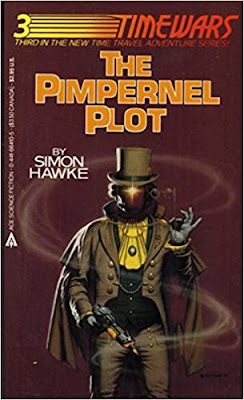 TIME WARS #3THE PIMPERNEL PLOT(1984)In the 27th Century, time travel allows international disputes to be settled by 'clocking' soldiers from the future into conflicts of the past to do battle in the Time Wars. The politicians and the corporate leaders who created an entire international economy based on the idea of 'an end to war in our time' believed that the past was absolute—had already happened, therefore it could not be changed. Unfortunately, they were wrong.
TIME WARS #3THE PIMPERNEL PLOT(1984)In the 27th Century, time travel allows international disputes to be settled by 'clocking' soldiers from the future into conflicts of the past to do battle in the Time Wars. The politicians and the corporate leaders who created an entire international economy based on the idea of 'an end to war in our time' believed that the past was absolute—had already happened, therefore it could not be changed. Unfortunately, they were wrong.The greater the number of people who 'clocked' back into the past, the greater were the odds of temporal contamination—changing history in ways that could disastrously affect the future. Major Lucas Priest, a veteran of the elite First Division of the Temporal Army Corps, is tasked to 'adjust' the blunder of a Temporal Intelligence agent who had accidentally caused the death of Sir Percy Blakeney, the wealthy English adventurer who saved French royalists from the guillotine. Now, someone else had to become the famous Scarlet Pimpernel and carry on his dangerous quest to cheat Madame Guillotine of her victims.
Trying to adjust key historical events during the bloody and tumultuous French Revolution might be challenging enough, but with rogue covert agents from Temporal Intelligence already on the scene to execute their own agenda, heads are gonna roll...
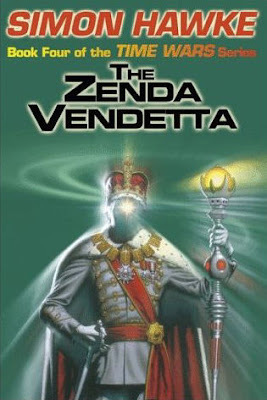 TIME WARS #4THE ZENDA VENDETTA(1985)In the kingdom of Ruritania, Prince Rudolf is about to be crowned king. Instead, due to the machinations of his half brother, he becomes the Prisoner of Zenda. That was back in the 19th century. But history is about to repeat itself with a twist. The Timekeepers, the terrorist underground from the 27th century, have traveled backward once again to try and sabotage the course of history. However insignificant Ruritania may be, the slightest tampering with the past will have incalculable consequences for the present.
TIME WARS #4THE ZENDA VENDETTA(1985)In the kingdom of Ruritania, Prince Rudolf is about to be crowned king. Instead, due to the machinations of his half brother, he becomes the Prisoner of Zenda. That was back in the 19th century. But history is about to repeat itself with a twist. The Timekeepers, the terrorist underground from the 27th century, have traveled backward once again to try and sabotage the course of history. However insignificant Ruritania may be, the slightest tampering with the past will have incalculable consequences for the present. The commandos of the Temporal Intelligence Agency, Lucas Priest, Finn Delaney, and Andre Cross have another temporal adjustment on their hands—and all they have for a guide is an obscure 19th century novel...
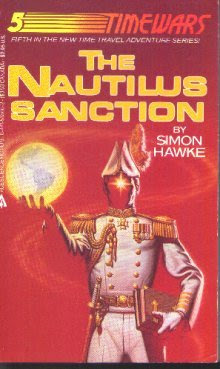 TIME WARS #5THE NAUTILUS SANCTION(1985)In the 27th century, the Russians construct the most powerful nuclear submarine of all time and christened it the Nautilus. It was intended to ensure Russian security and military supremacy, but it was never intended to be hijacked and equipped for time travel by a terrorist force determined to start the greatest war the world has ever seen—across the boundaries of time...
TIME WARS #5THE NAUTILUS SANCTION(1985)In the 27th century, the Russians construct the most powerful nuclear submarine of all time and christened it the Nautilus. It was intended to ensure Russian security and military supremacy, but it was never intended to be hijacked and equipped for time travel by a terrorist force determined to start the greatest war the world has ever seen—across the boundaries of time...Major Lucas Priest's elite commando unit of the U.S. Army Temporal Corps is sent back through time to find the Nautilus and stop it, if they can, and all they have to help them is a spirited Canadian harpooner named Ned Land and a middle-aged French writer of imaginative fiction named Jules Verne....
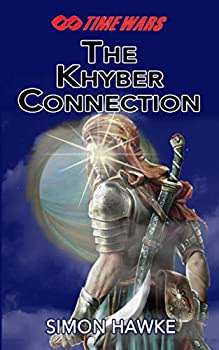 TIME WARS #6THE KHYBER CONNECTION(1986)Afghanistan: 1897...The Pathan tribes are in full-scale revolt against the British, but another, much more dangerous conflict is brewing in the Khyber Pass.
TIME WARS #6THE KHYBER CONNECTION(1986)Afghanistan: 1897...The Pathan tribes are in full-scale revolt against the British, but another, much more dangerous conflict is brewing in the Khyber Pass.The actions of the Time Wars have resulted in a confluence effect, bringing a parallel timeline into congruence with our own. One timeline must be disrupted to safeguard the existence of the other, and the first shot in the war between two timelines has already been fired. The Time Commandos' mission puts them squarely in the crossfire, along with a young British war correspondent named Winston Churchill and a native waterboy named Gunga Din.
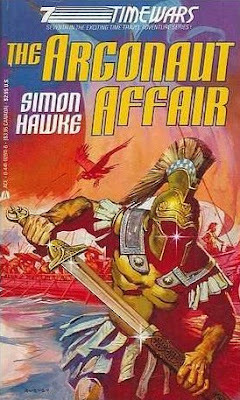 TIME WARS #7THE ARGONAUT AFFAIR(1987)It was the first time anyone had ever seen a real live centaur...When a mythical creature is captured by Observers from the 27th Century in the year 219 B.C., they realize something has gone drastically wrong. The actions of the Time Wars had brought about a congruence of two universes, with a confluence effect that had both timelines rippling and intersecting at various points throughout history. And where these confluence points occurred, it was possible to cross over from one universe into another.
TIME WARS #7THE ARGONAUT AFFAIR(1987)It was the first time anyone had ever seen a real live centaur...When a mythical creature is captured by Observers from the 27th Century in the year 219 B.C., they realize something has gone drastically wrong. The actions of the Time Wars had brought about a congruence of two universes, with a confluence effect that had both timelines rippling and intersecting at various points throughout history. And where these confluence points occurred, it was possible to cross over from one universe into another.And as if that were not bad enough, the appearance of a creature straight out of Greek mythology seemed to prove that physical laws were different in the other universe, which meant that more intelligence was needed, because the other universe had declared a temporal war to safeguard their own timestream. For the adjustment teams of Temporal Intelligence, this meant a whole new type of mission. Their job had always been to prevent historical disruptions. Now, it would be their mission to create them—in the opposing timeline. The Time Wars had suddenly been escalated into a new dimension...Literally.
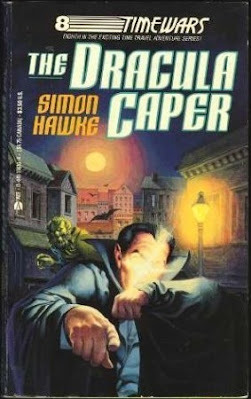 TIME WARS #8THE DRACULA CAPER(1988)A plague of vampires and werewolves falls on Victorian England in the late 1800's, but there's nothing supernatural about these creatures. They're genetically engineered monsters from the future, dropped into the past as a terrorist tactic in the Time Wars.
TIME WARS #8THE DRACULA CAPER(1988)A plague of vampires and werewolves falls on Victorian England in the late 1800's, but there's nothing supernatural about these creatures. They're genetically engineered monsters from the future, dropped into the past as a terrorist tactic in the Time Wars.To Scotland Yard, it's a mystery more baffling than any ever faced by Sherlock Holmes, so they turn to his creator for assistance. And as the foggy streets of London become a killing ground, the Time Commandos join forces with Sir Arthur Conan Doyle and H.G. Wells—who soon discovers the time machine he had envisioned has become a frightening reality—and an aspiring writer named Bram Stoker, who comes face to face with a Balkan nobleman named Dracula...
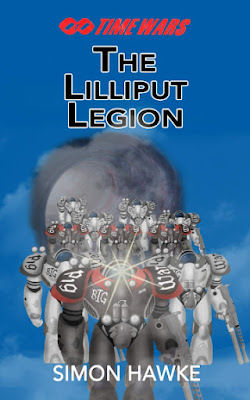 TIME WARS #9THE LILLIPUT LEGION(1989)They were miniature people, approximately six inches in height…In 18th century London, Dr. Lemuel Gulliver’s tale of encountering little people after being shipwrecked on an island are dismissed as the drunken ravings of a madman by everyone save the eccentric author, Jonathan Swift, and an observer from the Temporal Intelligence Agency, who is alarmed by Gulliver’s description of their weapons. The obviously traumatized surgeon has accurately described miniaturized versions of military ordnance that will not exist for over a thousand years.
TIME WARS #9THE LILLIPUT LEGION(1989)They were miniature people, approximately six inches in height…In 18th century London, Dr. Lemuel Gulliver’s tale of encountering little people after being shipwrecked on an island are dismissed as the drunken ravings of a madman by everyone save the eccentric author, Jonathan Swift, and an observer from the Temporal Intelligence Agency, who is alarmed by Gulliver’s description of their weapons. The obviously traumatized surgeon has accurately described miniaturized versions of military ordnance that will not exist for over a thousand years.“Dr. Gulliver described, in great detail, some of the weapons used by these little people, or ‘Lilliputians’, as his companion, Mr. Swift, referred to them,” the TIA observer wrote in his report. “From the lucid description of these miniature weapons and their function, they were unquestionably miniature lasers and autopulsers. From the description of their uniforms and tactics, these so-called Lilliputians sounded exactly like modern commandos, only on an incredible, miniature scale.”
Killed before he could finish his report, the agent’s last act was to transport Dr. Gulliver to the 27th century, where the astonished surgeon was confronted with the wonders of the future, and the Time Commandos were confronted with a new and highly dangerous threat—an army of bioengineered hominoids from a parallel universe, no more than six or seven inches tall, armed with lasers, plasma weapons, and jet packs…and the ability to travel through time.
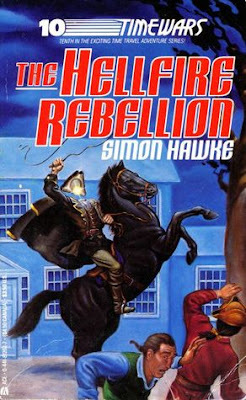 TIME WARS #10THE HELLFIRE REBELLION(1990)A demon straight from Hell…For a moment, they saw nothing. Then they heard the rapid beat of iron-shod hooves on cobblestones. A black-clad rider with a long, billowing cloak came hurtling at them from the shadows. He turned, reining in sharply, and the handsome, jet black stallion reared up, its forelegs pawing at the sky as the rider’s screeching laughter filled the air. He had no head. Boston, 1765. Sam Adams leads the Sons of Liberty as they agitate in favor of independence for the Thirteen Colonies. But something has gone very wrong with history. A terrifying, ghostly entity is galloping the streets of Boston in the dead of night, targeting rebels for assassination. And if he—or it—cannot be stopped, the Revolutionary War might never happen.
TIME WARS #10THE HELLFIRE REBELLION(1990)A demon straight from Hell…For a moment, they saw nothing. Then they heard the rapid beat of iron-shod hooves on cobblestones. A black-clad rider with a long, billowing cloak came hurtling at them from the shadows. He turned, reining in sharply, and the handsome, jet black stallion reared up, its forelegs pawing at the sky as the rider’s screeching laughter filled the air. He had no head. Boston, 1765. Sam Adams leads the Sons of Liberty as they agitate in favor of independence for the Thirteen Colonies. But something has gone very wrong with history. A terrifying, ghostly entity is galloping the streets of Boston in the dead of night, targeting rebels for assassination. And if he—or it—cannot be stopped, the Revolutionary War might never happen.The Time Commandos from the 27th Century again travel back into the past to find a phantom, and the only man they have to guide them is an enemy soldier from a parallel timeline, who might never get back home if he doesn’t help the people with whom he’s at war. However, if the headless horseman isn’t stopped, there may be no going home for anyone…ever again.
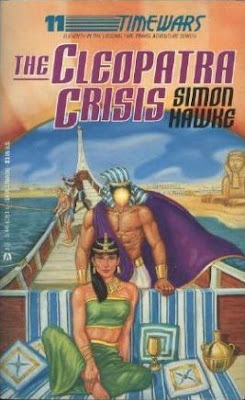 TIME WARS #11THE CLEOPATRA CRISIS(1990)Queen of the Nile...or cross-time terrorist? "I see violent death in your future," Lucan said. "There will be portents and warnings. You must not ignore them. For if you do, I see the image of your body bleeding, pierced with many wounds. You will not fall in battle, but at the hands of those you think your friends. Beware the Ides of March, Caesar. Beware the names of Casca, Brutus, Cassius, Cimber..." Ancient Rome, the Eternal City, was always full of intrigues and conspiracies, but agents from a parallel universe have introduced a new element of treachery—a plot to prevent Julius Caesar's murder and change the course of history. But is Caesar's mistress, the seductive Queen of Egypt, their unwitting pawn...or is she their cunning leader?
TIME WARS #11THE CLEOPATRA CRISIS(1990)Queen of the Nile...or cross-time terrorist? "I see violent death in your future," Lucan said. "There will be portents and warnings. You must not ignore them. For if you do, I see the image of your body bleeding, pierced with many wounds. You will not fall in battle, but at the hands of those you think your friends. Beware the Ides of March, Caesar. Beware the names of Casca, Brutus, Cassius, Cimber..." Ancient Rome, the Eternal City, was always full of intrigues and conspiracies, but agents from a parallel universe have introduced a new element of treachery—a plot to prevent Julius Caesar's murder and change the course of history. But is Caesar's mistress, the seductive Queen of Egypt, their unwitting pawn...or is she their cunning leader?The Time Commandos travel back to ancient Rome to unravel the mystery of a strange prophecy, one that not only foretold the day of Caesar's murder, but also the exact manner of his death, and even the names of his assassins...But with the timelines of two parallel universes intersecting, are any of the players really who they seem?
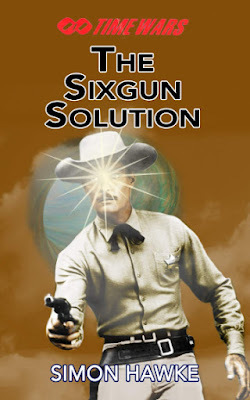 TIME WARS #12THE SIX-GUN SOLUTION(1991)Tombstone Time Warp! The year is 1881, and the most famous gunfight in history is about to take place at the O.K. Corral. But the Earps and the Clantons are not the only rival factions converging in the Wild West town of Tombstone, Arizona.
TIME WARS #12THE SIX-GUN SOLUTION(1991)Tombstone Time Warp! The year is 1881, and the most famous gunfight in history is about to take place at the O.K. Corral. But the Earps and the Clantons are not the only rival factions converging in the Wild West town of Tombstone, Arizona.The Time Commandos are sent back to the American frontier to investigate the disappearance of three missing agents, only to come up against an organized crime empire from the future, saboteurs from a parallel universe, genetically engineered spies, and lethal cross-time terrorists. To make matters even worse, two parallel timelines have started to converge in the exact same time and place, causing reality to ripple, threatening to overwhelm the timestream, and send history on a radical shift into the surreal...
Published on February 01, 2022 06:22
June 7, 2021
THE WACKIEST SHIP IN THE ARMY
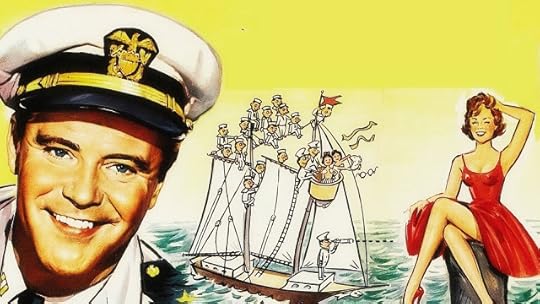 THE WACKIEST SHIP IN THE ARMY Taking advantage of staying home during the pandemic, my wife and I have been bingeing old movies we've never gotten around to viewing. Recently, the choice was an oddly titled, slightly schizophrenia film with Jack Lemmon and Ricky Nelson, The Wackiest Ship In The Army. My wife and I both enjoyed it, despite its inability to decide if it was a comedy set during the War in the Pacific, an adventurous war movie with a few laughs, or a sentimental, feel good, version of Hell In The Pacific.
THE WACKIEST SHIP IN THE ARMY Taking advantage of staying home during the pandemic, my wife and I have been bingeing old movies we've never gotten around to viewing. Recently, the choice was an oddly titled, slightly schizophrenia film with Jack Lemmon and Ricky Nelson, The Wackiest Ship In The Army. My wife and I both enjoyed it, despite its inability to decide if it was a comedy set during the War in the Pacific, an adventurous war movie with a few laughs, or a sentimental, feel good, version of Hell In The Pacific.
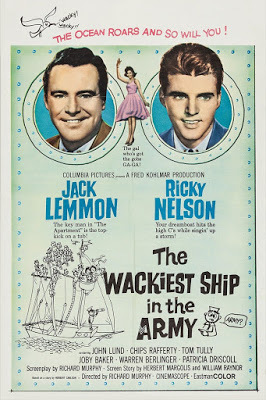 My wife has a habit of watching movies and TV shows while keeping Google open on her phone. This means everything we view is accompanied by her running commentary on the history of the film, the background of the actors—both the leads and the bit players—and whatever trivia IMDB coughs up. She's my best friend and I love her to forever and beyond, but sometimes she's like a living director's commentary track you can't turn off.
My wife has a habit of watching movies and TV shows while keeping Google open on her phone. This means everything we view is accompanied by her running commentary on the history of the film, the background of the actors—both the leads and the bit players—and whatever trivia IMDB coughs up. She's my best friend and I love her to forever and beyond, but sometimes she's like a living director's commentary track you can't turn off.
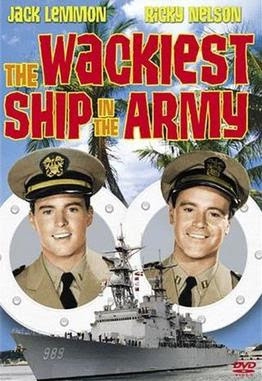 However, I'm not without my own set of quirks, one of which is the inability to pass by a tangential rabbit hole without doing my version of an Alice In Wonderland routine. I was already intrigued because I vaguely remembered there had been a television show based on the movie, although I couldn't remember seeing any episodes. When I gleaned the information from the credits that the film was based on the true story Big Fella Wash Wash in Argosy magazine, I was not only being sucked inexorably down the rabbit hole, I was picking up speed. In real life, the 27 yea old Lieutenant Meredith Rip Riddle (Rip Crandall in the movie) was justifiable proud when he received orders from the U.S. Navy to take command of his first ship, the USS Echo. Oddly, nobody had ever heard of the Echo, and it wasn’t long before. Riddle realizes he’s been hoodwinked when his new assignment turns out not to be a battleship or a destroyer, but a 40-year-old, twin-masted, flat-bottomed, wooden schooner of dubious seaworthiness.
However, I'm not without my own set of quirks, one of which is the inability to pass by a tangential rabbit hole without doing my version of an Alice In Wonderland routine. I was already intrigued because I vaguely remembered there had been a television show based on the movie, although I couldn't remember seeing any episodes. When I gleaned the information from the credits that the film was based on the true story Big Fella Wash Wash in Argosy magazine, I was not only being sucked inexorably down the rabbit hole, I was picking up speed. In real life, the 27 yea old Lieutenant Meredith Rip Riddle (Rip Crandall in the movie) was justifiable proud when he received orders from the U.S. Navy to take command of his first ship, the USS Echo. Oddly, nobody had ever heard of the Echo, and it wasn’t long before. Riddle realizes he’s been hoodwinked when his new assignment turns out not to be a battleship or a destroyer, but a 40-year-old, twin-masted, flat-bottomed, wooden schooner of dubious seaworthiness. An expert yachtsman in civilian life, Riddle knew he wouldn’t have a problem sailing what was more garbage scow than a battleship—but there were bigger challenges ahead. First, the crew of misfits assigned to the Echo didn’t know a jib from a jigger. Second—and far worse—Riddle finds out the ship is actually on loan from the U.S. Army, and comes with an Army major with whom Riddle is supposed to share command.
To top things off, the Echo turns out to have a crucial, top secret mission with hundreds of allied lives depending on its success. The plan is for Randall and his inept crew to disguise the Echo as a South Seas fishing scow in order to sail through waters heavily patrolled by the Japanese fleet. Their mission is to place coastal watchers behind enemy lines on islands under Japanese control. These watchers must hide on the islands, while being hunted by the enemy, in order to transmit the movements of the Japanese fleet.
The good news was the Echo herself as she was a sound ship despite appearances. Originally the property of the New Zealand government, the Echo had been given to the U.S. Army as a transport ship to carry cargo and supplies to Army bases in the South Pacific—which earned her an Army commendation. The better news was the aft mounted .50 caliber machine gun hidden by fishing nets on the Echo’s deck. The best news, however, was Rip Riddle himself. A native of Shelbyville, Tennessee, Riddle was a born leader and masterful at improvising on the fly. He would eventually serve in the Navy for more than 30 years, commanding six different ships—including the Echo. He also served as the chief engineering officer of the aircraft carrier USS Kearsarge, where he headed a staff of 600 men and 18 officers. Aside from it’s original mission with the Navy to transport the Island spotters, the Echo often found herself engaged in a variety of other hazardous escapades. Once, after a hurricane hit the Pacific islands, the Echo rescued several fishermen whose canoes were blown more than 100 miles away from their villages and had been given up for dead by their families. On their return, the ship was met by the ecstatic villagers who almost all paddled out in their canoes. This caused a problem. The celebration was attracting the attention of nearby Japanese planes, so the crew members and the rescued fishermen had to fend off the well-wishers attempting to climb aboard. Riddle’s misadventures would eventually find their way into the July 1956 issue of the Men’s Adventure Magazine, Argosy. Under the title writers Marion Hargrove and Herb Carlson recounted the true story of the Echo’s Navy exploits, however, it was Argosy art director Bernard White who came up with the brilliant tag line, The Wackiest Ship in the Army, as a teaser on the magazine’s cover. As the lead story on page fifteen, , came with two teasers to grab readers’ attention...Take a creaking, crummy old schooner, a boot camp Navy crew, and some of the barest, most bucolic aborigines in the Pacific; mix them up with a global war, and you’ve got the ingredients of a rip-roaring adventure story—and every word of it is true...If a man could make his dream of adventure come true, this could well be it—The Editors The catchphrase and teaser hype did their job snagging not only readers, but also the attention of Columbia Pictures, who bought the rights to use the story as the basis for their 1960 movie comedy The Wackiest Ship in The Army, starring Jack Lemmon and Ricky Nelson. However, in typical Hollywood fashion there was something lost in the translation from page to screen. In this case it was the Army major who had joint command of the Echo. Even the fact the Echo was an Army transport scow on loan to the Navy somehow missed the boat, so to speak. This left movie viewers with the wonderfully intriguing Wackiest Ship in the Army title and absolutely no idea what it meant. I can only assume the reference got left on the cutting room floor to make room for another song by Ricky Nelson. Known for writing the script for the 1951 film, You're in the Navy Now, Richard Murphy directed Wackiest Ship in the Army and also adapted the screenplay from the source material. Originally, the film was to star Ernie Kovacs as Rip Crandall (the movie version of Rip Riddle) and Jack Lemmon as his bumbling ensign. But as the deadline for the start of principal photography approached, Kovacs was on duty elsewhere. There was also a concern that despite his name value, Lemmon—who actually served as a U.S. Navy Ensign in World War II—looked too old for the role as the Echo’s inexperienced ensign. The solution to both dilemmas was to give Lemmon a field promotion (more of an Army term, but appropriate) to the lead role as Lieutenant Crandall, and bring actor/singer/teen heartthrob Ricky Nelson aboard as the naïve, but mostly competent ensign. Like Rip Riddle transforming into Rip Crandall, the USS Echo originally underwent a name changed to the USS Fiesta for the movie version. Fortunately, the ship was rechristened the Echo before filming started. But, like Kovacs, the real Echo wasn’t available, which meant brining in a 72 foot gaff-rigged schooner—whose real name was Fiesta—to play the part. The Echo’s standin was built entirely of teakwood in Hong Kong in 1932, and sported a 165hp auxiliary diesel engine, weighed 28 net tons, drew 8 feet of water and could make 7.5 knots under power. Location filming for Wackiest Ship in the Army was done on the Hawaiian islands of Oahu, Hawaii, and Kauai. The U.S. Navy also provided extensive cooperation allowing the producers to film at Pearl Harbor. The movie is predictable, but it stays afloat for a number of reasons—the storyline is intriguing and has a couple of unexpected twists; the action is well filmed and maintains a strong sense of tension; the supporting cast is excellent, managing to get laughs more from their facial expressions and dialogue timing with only a little slapstick; Ricky Nelson provides the perfect foil as the lynchpin between the incompetence of the crew and the motivator to get them to pull together; and then there’s Jack Lemmon, who turns in an early version of what would become his trademark style of exasperation mixed with determination. Should you see the film, absolutely—but there’s more. The movie did big enough box office for NBC to try translating the concept to the small screen. Airing in 1965, the show was produced by Harry Ackerman, and directed and written by Danny Arnold. The show retained the Wackiest Ship in the Army moniker, but sailed closer to the source material than the movie—even down to the Army/Navy having joint command of the schooner—which was rechristened yet again as the USS Kiwi. For the TV series, Cary Collins starred as Navy Lieutenant, junior grade Richard Rip Riddle—who has gotten his real name back and is in command when the vessel is afloat—and Jack Warden as Army Major Simon Butcher—who's in charge of shore operations. Mike Kellin who played Chief Mate Jack MacCarthy in the movie gets the same role on the television series—the only actor to make the transition from big screen to small. Though billed as a comedy, at an hour in length it had nothing in common with such service related sitcoms as McHale’s Navy or Sergeant Bilko. While the crew still got up to some screwball antics, the emphasis was on the adventure of each weekly assignment. This dual personality—is it a comedy or is it an action show—was something the TV series shared with the movie version. Fortunately, the TV series did not make use of a soundtrack to tell viewers when to laugh as was the practice for TV comedies. The series was, of course, set in the Pacific theater of World War II as the misfit crew of the leaky wooden twin-masted schooner USS Kiwi are tasked with placing spies behind Japanese lines. The con-combatant fishing boat appearance of the Kiwi helps fool the Japanese as it sails through mine infested enemy waters under the false colors of the Swiss flag. A ship with two masters, however, means less than smooth sailing as Navy Lieutenant Riddle and Army Major Butcher are almost always at odds. Although the show lasted only one season, it did spawn an original TV tie-in paperback written by Lee Berman and published by Popular Library in 1965—The roughest, toughest, wildest mission of the Wackiest Ship in the Army...What is the good ship Kiwi? Is she fist or Fowl? Does she belong to the Army? Major Simon Butcher is damned certain she does. Or does she belong to the Navy as Lt. Rip Riddle knows she does? On thing is sure, on this mission the Kiwi is heading into the biggest dose of trouble she’s ever seen—including the two beauties in disguise, and enemy scientist, and a secret weapon that could blow the U.S. forces right out of the Pacific. Maybe I’m easy to please, but the Jack Lemon movie version of The Wackiest Ship in the Army, the related TV series, the TV tie-in novel, and the original story that started it all in Argosy magazine, have all entertained me. As for the real USS Echo—she was decommissioned in 1944, and returned to the Army, who returned her to the New Zealand Government. After a lengthy and varied career—including serving as a floating bar—she eventually ended her days as a museum in Picton, New Zealand. Unfortunately, she was poorly maintained over the years and her condition deteriorated to a dangerous state beyond repair. She was demolished in 2015—110 years after her launching in 1905.
Published on June 07, 2021 19:25
January 22, 2021
THE FISTS OF ROBERT E. HOWARD...
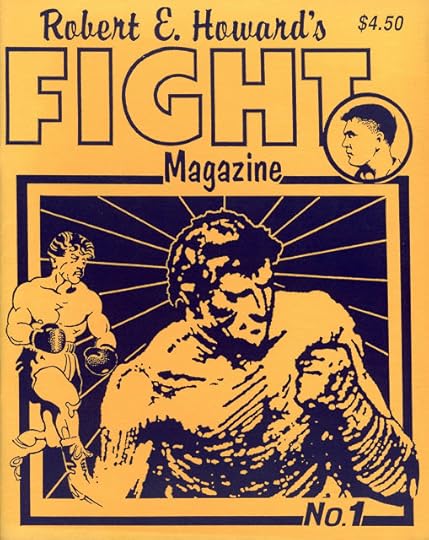 THE FISTS OF ROBERT E. HOWARD In honor of REH's birthday, I amrerunning this column from 2017
The minute I stepped ashore from the Sea Girl, merchantman, I had a hunch that there would be trouble. This hunch was caused by seeing some of the crew of the Dauntless. The men on the Dauntless have disliked the Sea Girl’s crew ever since our skipper took their captain to a cleaning on the wharfs of Zanzibar – them being narrow-minded that way. They claimed that the old man had a knuckle-duster on his right, which is ridiculous and a dirty lie. He had it on his left.
~ Robert E. Howard, The Pit of the Serpent
THE FISTS OF ROBERT E. HOWARD In honor of REH's birthday, I amrerunning this column from 2017
The minute I stepped ashore from the Sea Girl, merchantman, I had a hunch that there would be trouble. This hunch was caused by seeing some of the crew of the Dauntless. The men on the Dauntless have disliked the Sea Girl’s crew ever since our skipper took their captain to a cleaning on the wharfs of Zanzibar – them being narrow-minded that way. They claimed that the old man had a knuckle-duster on his right, which is ridiculous and a dirty lie. He had it on his left.
~ Robert E. Howard, The Pit of the Serpent[image error] Although best known as the creator of Conan the Barbarian, Solomon Kane, and other sword and sorcery characters, Robert E. Howard (REH) had a lifelong interest in boxing, attending fights and avidly following the careers of his favorite fighters. Even though as a child he was bookish and intellectual, in his teen years he took up bodybuilding and eventually entered the ring as an amateur boxer.
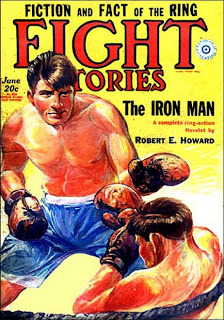 During the height of the pulp magazine era from the late ‘20s through the ‘30s, REH used this background to make a good living banging out boxing tales for the likes of Fight Stories Magazine, Action Stories, Sport Story, Jack Dempsey’s Fight Magazine, and others. REH actually claimed his fictional fight tales—especially The Iron Man, and the adventures of Sailor Steve Costigan—to be among the best of his works. Primarily humorous in nature, Howard’s most popular and in demand boxing stories featured Sailor Steve Costigan. These tales were both creatively and financially critical to Howard’s development as a writer.
During the height of the pulp magazine era from the late ‘20s through the ‘30s, REH used this background to make a good living banging out boxing tales for the likes of Fight Stories Magazine, Action Stories, Sport Story, Jack Dempsey’s Fight Magazine, and others. REH actually claimed his fictional fight tales—especially The Iron Man, and the adventures of Sailor Steve Costigan—to be among the best of his works. Primarily humorous in nature, Howard’s most popular and in demand boxing stories featured Sailor Steve Costigan. These tales were both creatively and financially critical to Howard’s development as a writer.Costigan was a lovable, hard-fisted, and innocent semipro pugilist who regularly squared-off against dastardly villains in exotic ports of call. Tales featuring Costigan were at times laugh out loud funny and brilliant examples of what, in writing circles, is referred to as an unreliable narrator. Written in first person, the voiceof Sailor Steve Costigan is full of malapropisms and creative, near-swear invective.
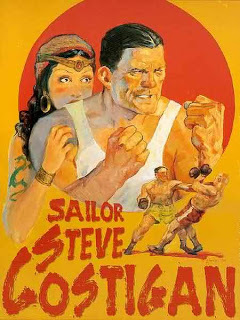 As the undisputed champion of the merchant marine Sea Girl, Costigan has a heart of gold, fists of steel, and a head full of rocks, all of which get him—and his bulldog Mike—tossed into constant trouble. Costigan is lovable for two reasons. First, he is just not smart enough to do anything other than punch his way clear of trouble. And second, when he starts punching, every reader feels the joy of the underdog overcoming the odds with the solid landing of every blow.
As the undisputed champion of the merchant marine Sea Girl, Costigan has a heart of gold, fists of steel, and a head full of rocks, all of which get him—and his bulldog Mike—tossed into constant trouble. Costigan is lovable for two reasons. First, he is just not smart enough to do anything other than punch his way clear of trouble. And second, when he starts punching, every reader feels the joy of the underdog overcoming the odds with the solid landing of every blow. No matter how ridiculous the situation he places Costigan in, REH never ridicules the character, always putting Costigan on the side of the angels. Readers know they should always bet on Costigan coming through victorious in a fight, and they would be more than willing to share a beer with him afterward. Not too many readers would want to share suds with the brutal Conan or the dour Solomon Kane. Costigan is accessible, a larger than life everyman.
Not all of REH’s boxing stories are funny. Aside from essays exploring what attributes REH believed made a great boxer, his other boxing tales were alive with the sound and the fury of the real world of the square circle. In particular, his novelette Iron Man, is a revered saga for those followers not just of REH, but of boxing enthusiasts in general.
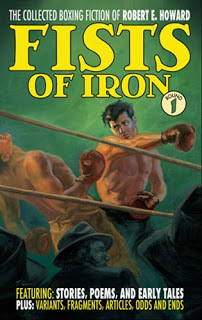 Over the years, REH’s boxing fiction has been reprinted in various incomplete collections. However, between 2013 and 2015, the ultimate collection of REH’s boxing fiction was amassed by the Robert E. Howard Foundation Press and published in the four volume Fists of Iron collection. This has finally given these overlooked works their rightful place in the Howard pantheon.
Over the years, REH’s boxing fiction has been reprinted in various incomplete collections. However, between 2013 and 2015, the ultimate collection of REH’s boxing fiction was amassed by the Robert E. Howard Foundation Press and published in the four volume Fists of Iron collection. This has finally given these overlooked works their rightful place in the Howard pantheon. These beautifully bound and numbered, hardcover editions sport stunning, pulp inspired wrap around covers and contain every story, partial story, and scrap of idea Howard produced in relation to the sweet science of boxing. Editors, Mark Finn, Patrice Louinet, and Christopher Gruber each contributed insightful and extensive introductions to the volumes, in what was clearly a labor of love and appreciation for REH’s work.
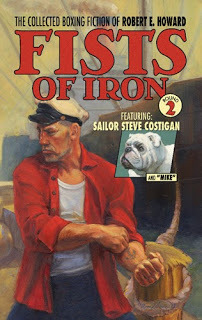 The complete compendium of Fist of Iron has not only become a highly sought after collector’s item, but has preserved the two-fisted tales that helped a generation of readers to fight through the Great Depression and the tough years to follow. Even today, REH’s boxing fiction reads with immediacy and storytelling power. If you’ve never met, or never heard of REH’s boxing characters Sailor Steve Costigan, Kid Allison, Mike O’Brien, or Dennis Dorgan, now is the time to lace up your gloves, put up your dukes, and climb into the ring.
The complete compendium of Fist of Iron has not only become a highly sought after collector’s item, but has preserved the two-fisted tales that helped a generation of readers to fight through the Great Depression and the tough years to follow. Even today, REH’s boxing fiction reads with immediacy and storytelling power. If you’ve never met, or never heard of REH’s boxing characters Sailor Steve Costigan, Kid Allison, Mike O’Brien, or Dennis Dorgan, now is the time to lace up your gloves, put up your dukes, and climb into the ring.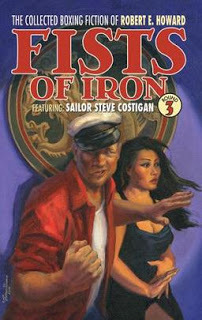
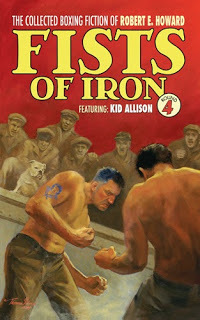 ********NOTE: I would be remiss at this point if I did not mention a collection of boxing tales inspired by REH’s Sailor Steve Costigan Tales. Mark Finn, one of the editors behind the Fists of Iron collection created a series of short stories featuring a two-fisted character as a homage to REH’s Sailor Steve Costigan. As the editor of the Fight Card series of novels (now 50 strong), I had the pleasure of editing and publishing these stories in the collection,
Fight Card: The Adventures of Sailor Tom Sharkey
.
********NOTE: I would be remiss at this point if I did not mention a collection of boxing tales inspired by REH’s Sailor Steve Costigan Tales. Mark Finn, one of the editors behind the Fists of Iron collection created a series of short stories featuring a two-fisted character as a homage to REH’s Sailor Steve Costigan. As the editor of the Fight Card series of novels (now 50 strong), I had the pleasure of editing and publishing these stories in the collection,
Fight Card: The Adventures of Sailor Tom Sharkey
.
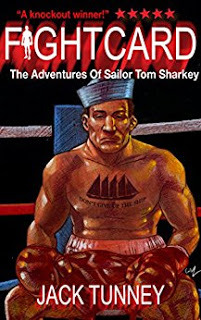 Channeling the best of REH’s boxing tales, The Adventures of Sailor Tom Sharkey are a terrific blend of weird, historical, and humorous boxing stories to be read and enjoyed. As for Sailor Tom Sharkey himself, he is one of the greatest heavyweight boxers to enter the legendary squared circle during the Golden Age of Boxing. Standing a mere 5’ 8”, Sailor Tom Sharkey is one of boxing’s most feared opponents…Gentleman Jim Corbett, Bob Fitzsimmons, Kid McCoy, and Jim Jeffries all agreed he was their fiercest opponent and gave them their toughest fights. A colorful boxer both in the ring and out, he retired in 1904 after several legendary and controversial failed attempts to win the championship belt. That’s the story you know, but it’s not the end of Sharkey’s story—not by a long shot. The Adventures of Sailor Tom Sharkey collects the rowdy, bawdy, burlesque, tall Texas tales of Sailor Tom Sharkey’s shenanigans after he hung up his professional gloves. There’s Sharkey’s brush with Hollywood’s “It” Girl, Clara Bow. There are chills as Sharkey and Kid McCoy face down a maniacal bandit. And the heat gets turned up when Sharkey rides the rails with Jim Jeffries and the Vaudeville Carnival into a clash with mad scientists and mummified menaces. And for the softer side of Sharkey, you can watch as he plays Santa Claus to a bunch of Tammany Hall orphans and ends up with a tiger by the tail—literally. These are the untold tales of the wildest tale-teller of boxing’s golden age…
Channeling the best of REH’s boxing tales, The Adventures of Sailor Tom Sharkey are a terrific blend of weird, historical, and humorous boxing stories to be read and enjoyed. As for Sailor Tom Sharkey himself, he is one of the greatest heavyweight boxers to enter the legendary squared circle during the Golden Age of Boxing. Standing a mere 5’ 8”, Sailor Tom Sharkey is one of boxing’s most feared opponents…Gentleman Jim Corbett, Bob Fitzsimmons, Kid McCoy, and Jim Jeffries all agreed he was their fiercest opponent and gave them their toughest fights. A colorful boxer both in the ring and out, he retired in 1904 after several legendary and controversial failed attempts to win the championship belt. That’s the story you know, but it’s not the end of Sharkey’s story—not by a long shot. The Adventures of Sailor Tom Sharkey collects the rowdy, bawdy, burlesque, tall Texas tales of Sailor Tom Sharkey’s shenanigans after he hung up his professional gloves. There’s Sharkey’s brush with Hollywood’s “It” Girl, Clara Bow. There are chills as Sharkey and Kid McCoy face down a maniacal bandit. And the heat gets turned up when Sharkey rides the rails with Jim Jeffries and the Vaudeville Carnival into a clash with mad scientists and mummified menaces. And for the softer side of Sharkey, you can watch as he plays Santa Claus to a bunch of Tammany Hall orphans and ends up with a tiger by the tail—literally. These are the untold tales of the wildest tale-teller of boxing’s golden age…
Published on January 22, 2021 05:56
July 18, 2020
SIX-GUN JUSTICE PODCASTEPISODE ELEVENWESTERN TV TIE-IN NO...
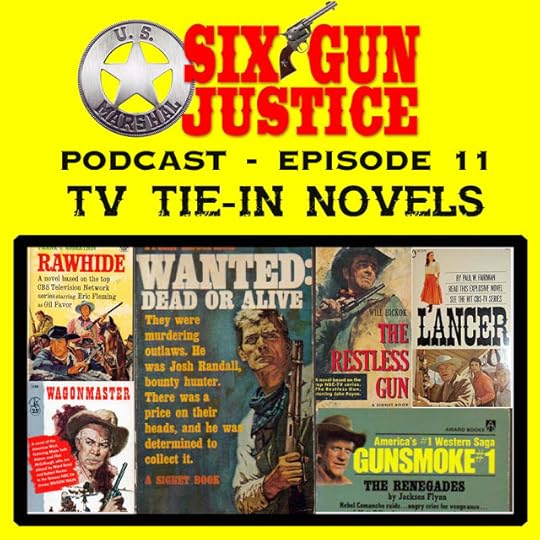 SIX-GUN JUSTICE PODCASTEPISODE ELEVENWESTERN TV TIE-IN NOVELSIt's Monday morning once again, wranglers, and time to get the herd up and moving with episode eleven of the Six-Gun Justice Podcast...This week, co-hosts Paul Bishop and Richard Prosch ride roughshod through the world of Western TV tie-in novels, from the obscure to the well known; from original tie-in novels to script novelizations; from the names behind the names to the double dealing, bait and switch, backroom scandals. Available now for streaming on all major podcast platforms or by using the player below...
SIX-GUN JUSTICE PODCASTEPISODE ELEVENWESTERN TV TIE-IN NOVELSIt's Monday morning once again, wranglers, and time to get the herd up and moving with episode eleven of the Six-Gun Justice Podcast...This week, co-hosts Paul Bishop and Richard Prosch ride roughshod through the world of Western TV tie-in novels, from the obscure to the well known; from original tie-in novels to script novelizations; from the names behind the names to the double dealing, bait and switch, backroom scandals. Available now for streaming on all major podcast platforms or by using the player below...
Published on July 18, 2020 09:31
May 31, 2020
SIX-GUN JUSTICE SPEED LISTEN���PICCADILLY COWBOYS
 SIX-GUN JUSTICE SPEED LISTENTHE PICCADILLY COWBOYSAND THEADULT WESTERN PHENOMENONIt's time again for another Six-Gun Justice Speed Listen. Step on into the sheriff���s office, pour yourself a cup of strong black brew, sit down in that hardback chair over there, make yourself comfortable by tilting it back against the wall, and listen in as Six-Gun Justice co-host Paul Bishop shares everything you need to know in fifteen minutes (give or take) about the dastardly Piccadilly Cowboys and the sex and six-gun Adult Western phenomenon that followed them.
SIX-GUN JUSTICE SPEED LISTENTHE PICCADILLY COWBOYSAND THEADULT WESTERN PHENOMENONIt's time again for another Six-Gun Justice Speed Listen. Step on into the sheriff���s office, pour yourself a cup of strong black brew, sit down in that hardback chair over there, make yourself comfortable by tilting it back against the wall, and listen in as Six-Gun Justice co-host Paul Bishop shares everything you need to know in fifteen minutes (give or take) about the dastardly Piccadilly Cowboys and the sex and six-gun Adult Western phenomenon that followed them.You can find this installment on all major podcast streaming platforms or by utilizing the player below...
Published on May 31, 2020 15:21
SIX-GUN JUSTICE SPEED LISTEN—PICCADILLY COWBOYS
 SIX-GUN JUSTICE SPEED LISTENTHE PICCADILLY COWBOYSAND THEADULT WESTERN PHENOMENONIt's time again for another Six-Gun Justice Speed Listen. Step on into the sheriff’s office, pour yourself a cup of strong black brew, sit down in that hardback chair over there, make yourself comfortable by tilting it back against the wall, and listen in as Six-Gun Justice co-host Paul Bishop shares everything you need to know in fifteen minutes (give or take) about the dastardly Piccadilly Cowboys and the sex and six-gun Adult Western phenomenon that followed them.
SIX-GUN JUSTICE SPEED LISTENTHE PICCADILLY COWBOYSAND THEADULT WESTERN PHENOMENONIt's time again for another Six-Gun Justice Speed Listen. Step on into the sheriff’s office, pour yourself a cup of strong black brew, sit down in that hardback chair over there, make yourself comfortable by tilting it back against the wall, and listen in as Six-Gun Justice co-host Paul Bishop shares everything you need to know in fifteen minutes (give or take) about the dastardly Piccadilly Cowboys and the sex and six-gun Adult Western phenomenon that followed them.You can find this installment on all major podcast streaming platforms or by utilizing the player below...
Published on May 31, 2020 15:21
May 7, 2020
SIX-GUN JUSTICE PODCAST SPEED LISTEN #5
 SIX-GUN JUSTICE PODCASTSPEED LISTEN #5TRUE GRIT Do the quarantine blues have you ready to sing Tex Ritter's cowboy lament, There was blood on the saddle and blood all around, and a great big puddle of blood on the ground, (also sung endlessly by Big Al in Disneyland's Country Bear's Jamboree attraction), then posse up with Six-Gun Justice co-host Paul Bishop for this new Six-Gun Justice Speed Listen installment tracking down True Grit. Everything you need to know about the iconic novel, the original film with John Wayne, and the Cohen brothers' 2010 'reimagining' of the core story—all in a fast and furious 15 minutes...Available now on all your favorite podcast streaming platforms or by utilizing the player below...
SIX-GUN JUSTICE PODCASTSPEED LISTEN #5TRUE GRIT Do the quarantine blues have you ready to sing Tex Ritter's cowboy lament, There was blood on the saddle and blood all around, and a great big puddle of blood on the ground, (also sung endlessly by Big Al in Disneyland's Country Bear's Jamboree attraction), then posse up with Six-Gun Justice co-host Paul Bishop for this new Six-Gun Justice Speed Listen installment tracking down True Grit. Everything you need to know about the iconic novel, the original film with John Wayne, and the Cohen brothers' 2010 'reimagining' of the core story—all in a fast and furious 15 minutes...Available now on all your favorite podcast streaming platforms or by utilizing the player below... Six-Gun Justice Speed Listens are bi-weekly mini-podcast installments (15 minutes or less) recorded in support of the full-length Six-Gun Justice Podcastepisodes. Regular co-hosts Paul Bishop and Richard Prosch trade off hosting Speed Listen installments while continuing to host the regular Six-Gun Justice Podcast episodes together...
Published on May 07, 2020 16:04
SIX-GUN JUSTICE CONVERSATIONS���CHUCK DIXON
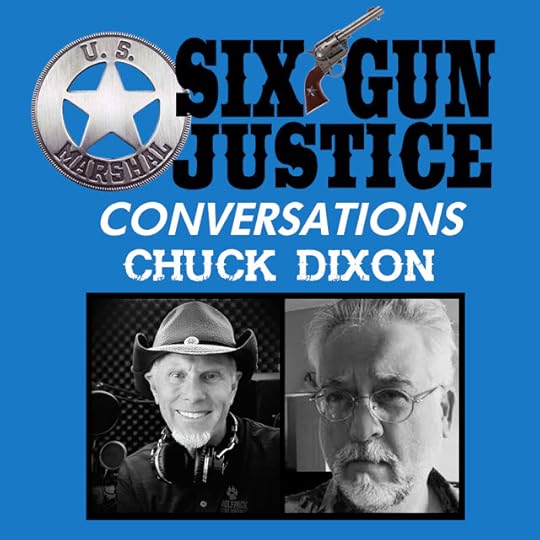 SIX-GUN JUSTICE CONVERSATIONSCHUCK DIXON
SIX-GUN JUSTICE CONVERSATIONSCHUCK DIXON Six-Gun Justice Conversations are occasional bonus features in which Six-Gun Justice co-hosts Paul Bishop or Richard Prosch get to hang out in the virtual Six-Gun Justice Saloon chewing the jerky with friends and writers who also love the western genre. There is no agenda or any particular western subject, simply an informal fifteen minute chat about westerns in whatever media comes up. In this first Six-Gun Justice Conversation, Paul downs some bad whiskey and pickled pigs feet along with comic book legend and western lover Chuck Dixon...
Like the full-length Six-Gun Justice Podcast episodes and the Six-Gun Justice Speed Listens, the bonus Six-Gun Justice Conversationsare available on all your favorite podcast platforms or simply listen by clicking the player below...
Published on May 07, 2020 16:01
SIX-GUN JUSTICE CONVERSATIONS—CHUCK DIXON
 SIX-GUN JUSTICE CONVERSATIONSCHUCK DIXON
SIX-GUN JUSTICE CONVERSATIONSCHUCK DIXON Six-Gun Justice Conversations are occasional bonus features in which Six-Gun Justice co-hosts Paul Bishop or Richard Prosch get to hang out in the virtual Six-Gun Justice Saloon chewing the jerky with friends and writers who also love the western genre. There is no agenda or any particular western subject, simply an informal fifteen minute chat about westerns in whatever media comes up. In this first Six-Gun Justice Conversation, Paul downs some bad whiskey and pickled pigs feet along with comic book legend and western lover Chuck Dixon...
Like the full-length Six-Gun Justice Podcast episodes and the Six-Gun Justice Speed Listens, the bonus Six-Gun Justice Conversationsare available on all your favorite podcast platforms or simply listen by clicking the player below...
Published on May 07, 2020 16:01



